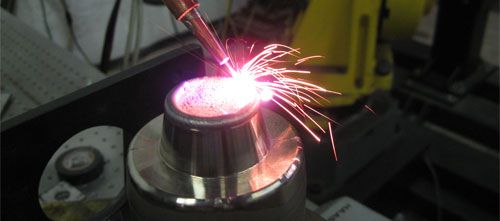Laser cladding—also referred to as laser metal deposition or Laser weld overlay—is a manufacturing technique used to add metal material to the surface of a component. It is generally used to create a protective coating that increases the functionality of the part or product. However, it can also be used to repair worn or damaged surfaces.
The following blog post provides an overview of the laser cladding process, outlining how it works, typical applications, materials used, and key advantages.
How Does the Laser Cladding Process Work?
As suggested by the name, the laser cladding process involves the use of a laser. The laser scans across the surface of the workpiece, creating melt pools in targeted areas. At the same time, a stream of metallic powder or wire is introduced to the targeted areas, which allows the laser to melt the material. The short exposure time reduces the amount of heat and therefore the heat affected zone and enables the workpiece and coating material to cool quickly. The result is a metallurgically bonded coating layer that is tougher than one created using the thermal spray coating method and safer to create than one made through the hard chromium plating method.
Applications of the Laser Cladding Process
Since the laser cladding process can add protective coatings and restore worn/damaged surfaces, it finds use in many industries. For example:
- In the construction industry, it is used to coat various machines and systems to protect them against corrosion, impact, and wear. The created coatings help extend the service life of the equipment, reducing repair and replacement costs for construction companies.
- In the oil and gas industry, it is used to coat cutting and drilling tools. These components are regularly subjected to stresses that can reduce their service life without proper wear protection. The laser clad process increases the surface durability of the tooling, allowing it to withstand long-term use.
- In the mining industry, it is used to coat hydraulic cylinders. The coatings on hydraulic cylinders are highly susceptible to corrosion in mining facilities, which can lead to leaks. Coatings created through the laser cladding process are longer-lasting than ones made through the chrome plating process, which can lead to significant cost savings over the years.
What Materials Can Be Used With the Laser Cladding Process?
The laser cladding process can be performed with a broad selection of metals, including, but not limited to, the following:
- Aluminum alloys
- Cobalt alloys
- Copper alloys
- Nickel (self-fluxing) alloys
- Stainless steels
- Superalloys
- Titanium alloys
- Tool steels
Advantages of Laser Cladding
There are many advantages to using laser cladding over other coating methods. For example:
- It allows for the precision positioning of coating materials, enabling coaters to target specific areas on the component.
- It creates layers that are more impact resistant than ones made through the thermal spray coating method, which can lead to better protection for components.
- It produces layers with little to no porosity, which creates denser (>99.9% density) coatings.
- It requires relatively low heat input, generating a narrower heat-affected zone (HAZ).
- It generates minimal distortion in the workpiece, reducing the need for post-coating processing.
- It accommodates the use of laser power modulation technology, which allows for better thermal control.
Learn More About Laser Cladding From Titanova
Want to learn more about the laser cladding process? Ask the experts at Titanova! We have extensive experience providing laser processing solutions, including laser cladding, to customers across a wide range of industries. Our team can answer any questions and address any concerns you may have about the process.
Do you require a laser cladding partner for your next project? We are here to help! Equipped with customized diode lasers, we can create the thinnest and purest weld overlay possible. Check out our laser cladding service page to learn more about our capabilities.



Comments are closed